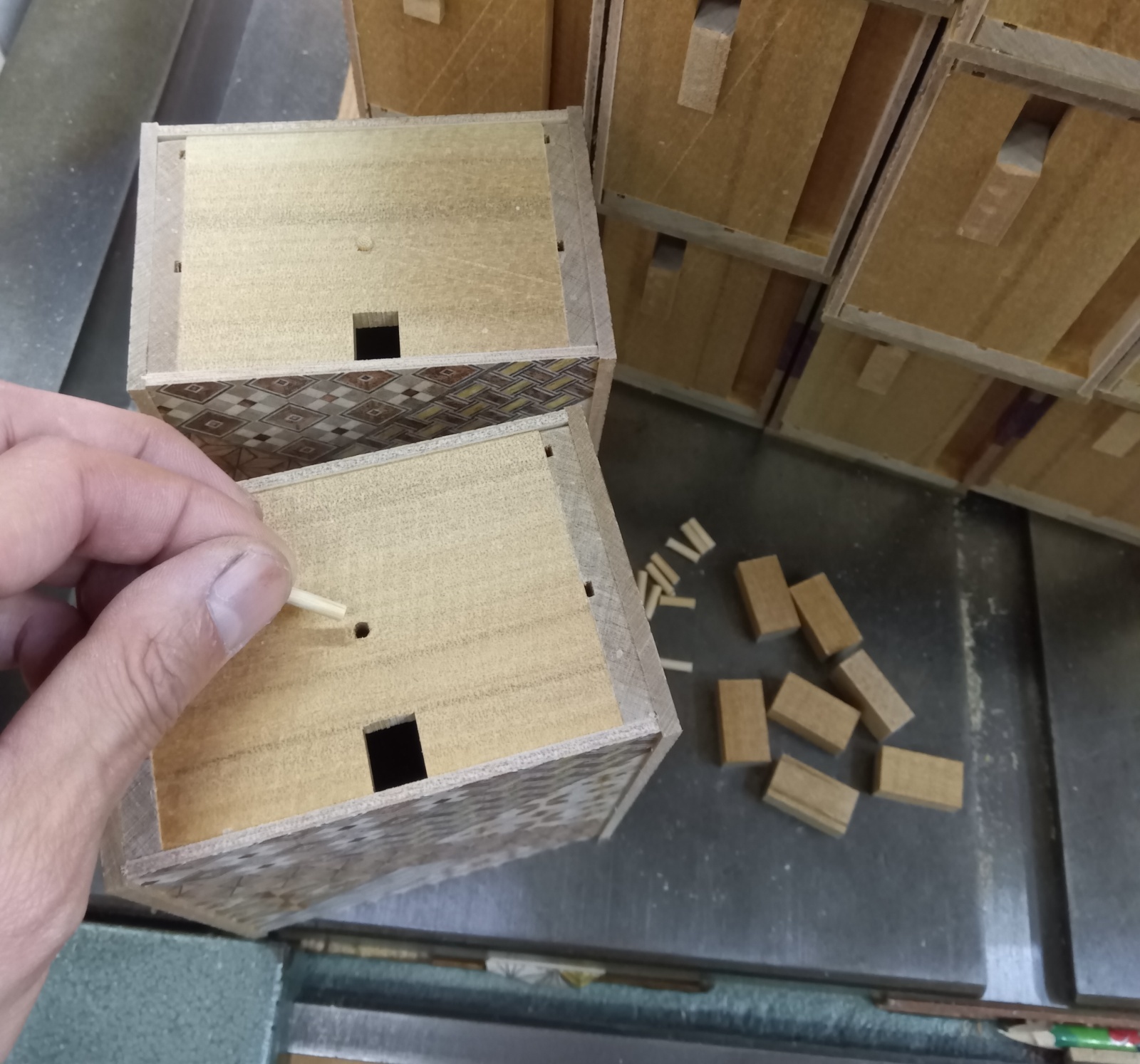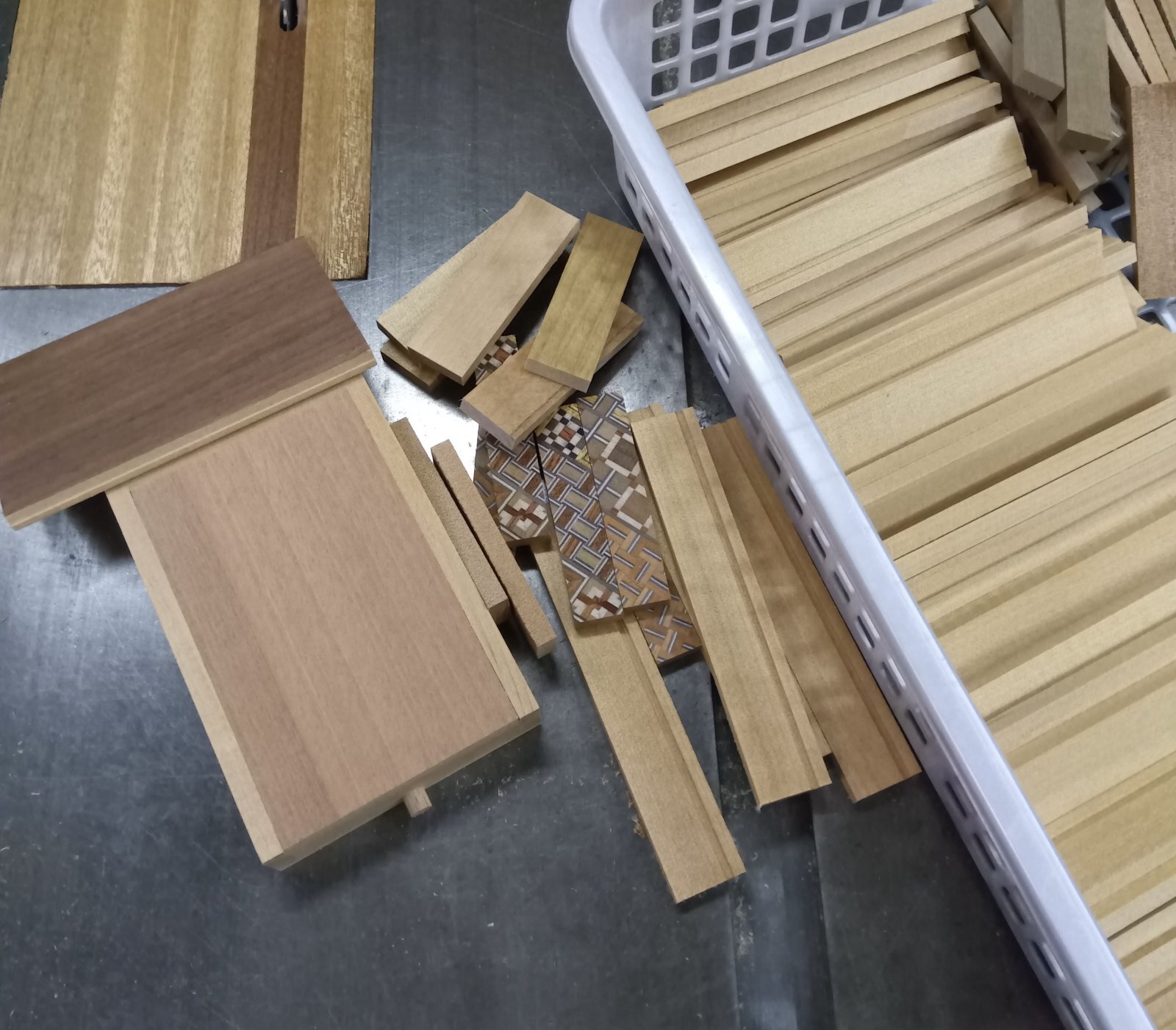5 sun Drawer box (4)
Today, I continued working on the 5-sun drawer Japanese puzzle box. The task for today was attaching the final panels, which are the Aruki (moving panel) side panels with "Kannuki(slide keys)". However, it's unfortunately raining today, so the humidity is quite high. While I managed to make the panels, I decided to hold off on attaching them for now. I've placed the completed panels and the main body of the box in a storage case to control the humidity. If the humidity drops tomorrow, I'll proceed with the attachment.
The photo shows the part of the main body where I will be attaching the "kannuki" panels. I am about to work on this section. For the one side with a 7-step mechanism, I'll be installing the "bocchi" and, on the opposite side, pre-attaching the pins to the aruki. The "bocchi" is the same as those used in a regular 5-sun box, and its mechanism is identical to a standard 7-step Japanese puzzle box. As I mentioned last day, for the side with the drawer, I’ll attach a pin to the aruki to stop its movement midway. This pin will catch in the groove of the internal shaft, halting the aruki's motion.
As for this pin, I used to use 3mm wooden sticks made from tropical wood, but now I’m using bamboo sticks instead. The reason is that the wooden sticks have become quite expensive!🤣 For the price of one wooden dowel, I can buy about ten bamboo ones. I have no idea why there’s such a price difference—maybe bamboo is just that cheap?🧐 In any case, I’ve switched to bamboo dowels, and they work perfectly fine. Bamboo can sometimes split along the grain or leave rough edges when cut, making it harder to work with, but for these small parts, it actually works to my advantage. I cut these pins to about 1cm and attach them to the small holes (photo). Afterward, I attach the yosegi panel with glue over the top, ensuring the pin stays securely in place.
Since I couldn’t do any gluing today, I worked on making the drawer, which is a process less affected by humidity. While I’ve only made the parts so far, all the necessary components are ready. The drawer is assembled using a total of seven parts (photo). The main material is Agathis wood, and the bottom is made of plywood from Shina wood. The front of the drawer includes a section of yosegi. I’ve repurposed leftover yosegi pieces that weren’t used for other puzzle boxes. Since the box’s exterior follows a traditional yosegi design, I matched the drawer’s front with it. For the solid wood version I’m making alongside this, I used Hoo wood for the front instead of yosegi. The handle is made from a 6mm Beech wood stick. I plan to assemble everything tomorrow or in the following days.
The photo shows the part of the main body where I will be attaching the "kannuki" panels. I am about to work on this section. For the one side with a 7-step mechanism, I'll be installing the "bocchi" and, on the opposite side, pre-attaching the pins to the aruki. The "bocchi" is the same as those used in a regular 5-sun box, and its mechanism is identical to a standard 7-step Japanese puzzle box. As I mentioned last day, for the side with the drawer, I’ll attach a pin to the aruki to stop its movement midway. This pin will catch in the groove of the internal shaft, halting the aruki's motion.
As for this pin, I used to use 3mm wooden sticks made from tropical wood, but now I’m using bamboo sticks instead. The reason is that the wooden sticks have become quite expensive!🤣 For the price of one wooden dowel, I can buy about ten bamboo ones. I have no idea why there’s such a price difference—maybe bamboo is just that cheap?🧐 In any case, I’ve switched to bamboo dowels, and they work perfectly fine. Bamboo can sometimes split along the grain or leave rough edges when cut, making it harder to work with, but for these small parts, it actually works to my advantage. I cut these pins to about 1cm and attach them to the small holes (photo). Afterward, I attach the yosegi panel with glue over the top, ensuring the pin stays securely in place.
Since I couldn’t do any gluing today, I worked on making the drawer, which is a process less affected by humidity. While I’ve only made the parts so far, all the necessary components are ready. The drawer is assembled using a total of seven parts (photo). The main material is Agathis wood, and the bottom is made of plywood from Shina wood. The front of the drawer includes a section of yosegi. I’ve repurposed leftover yosegi pieces that weren’t used for other puzzle boxes. Since the box’s exterior follows a traditional yosegi design, I matched the drawer’s front with it. For the solid wood version I’m making alongside this, I used Hoo wood for the front instead of yosegi. The handle is made from a 6mm Beech wood stick. I plan to assemble everything tomorrow or in the following days.

